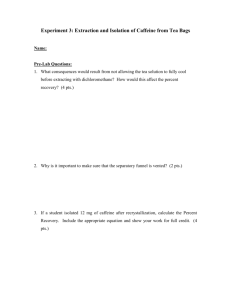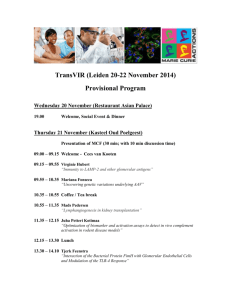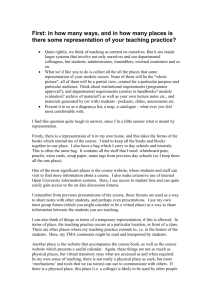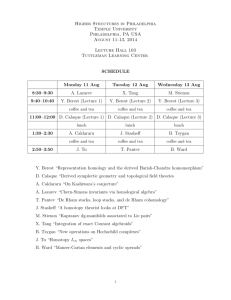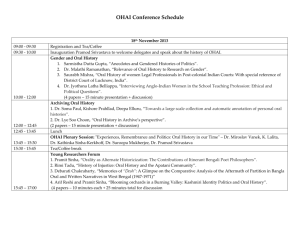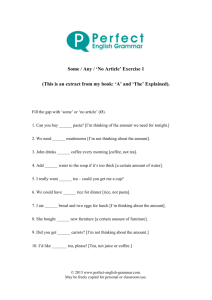Research Article
advertisement
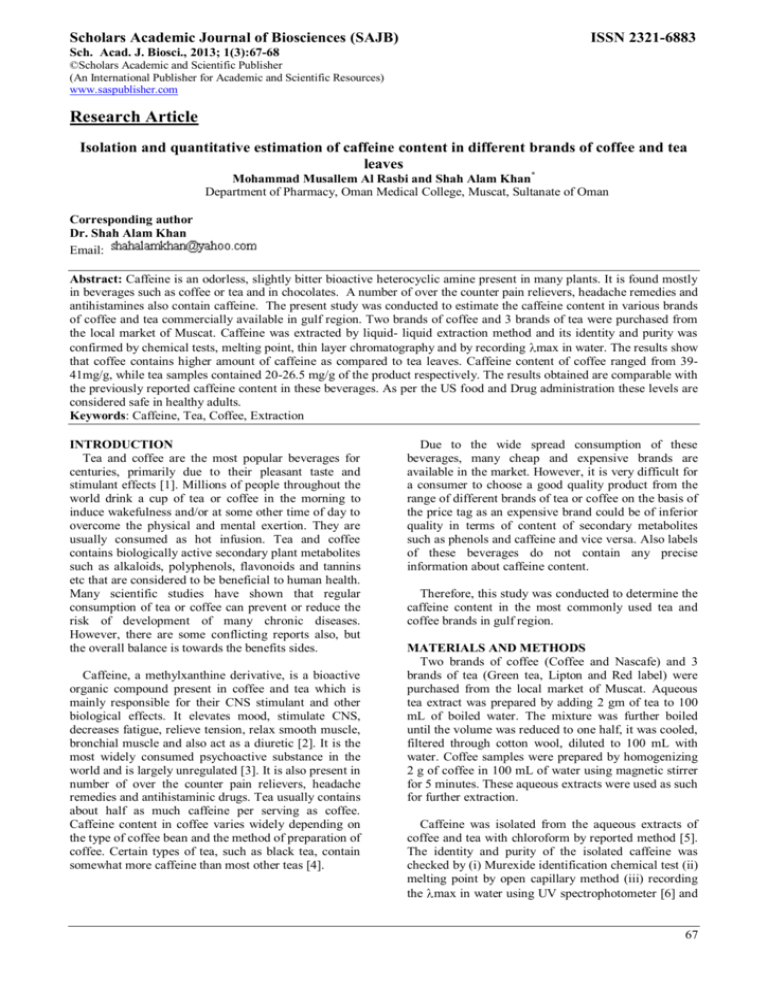
Scholars Academic Journal of Biosciences (SAJB) ISSN 2321-6883 Sch. Acad. J. Biosci., 2013; 1(3):67-68 ©Scholars Academic and Scientific Publisher (An International Publisher for Academic and Scientific Resources) www.saspublisher.com Research Article Isolation and quantitative estimation of caffeine content in different brands of coffee and tea leaves Mohammad Musallem Al Rasbi and Shah Alam Khan* Department of Pharmacy, Oman Medical College, Muscat, Sultanate of Oman Corresponding author Dr. Shah Alam Khan Email: Abstract: Caffeine is an odorless, slightly bitter bioactive heterocyclic amine present in many plants. It is found mostly in beverages such as coffee or tea and in chocolates. A number of over the counter pain relievers, headache remedies and antihistamines also contain caffeine. The present study was conducted to estimate the caffeine content in various brands of coffee and tea commercially available in gulf region. Two brands of coffee and 3 brands of tea were purchased from the local market of Muscat. Caffeine was extracted by liquid- liquid extraction method and its identity and purity was confirmed by chemical tests, melting point, thin layer chromatography and by recording max in water. The results show that coffee contains higher amount of caffeine as compared to tea leaves. Caffeine content of coffee ranged from 3941mg/g, while tea samples contained 20-26.5 mg/g of the product respectively. The results obtained are comparable with the previously reported caffeine content in these beverages. As per the US food and Drug administration these levels are considered safe in healthy adults. Keywords: Caffeine, Tea, Coffee, Extraction INTRODUCTION Tea and coffee are the most popular beverages for centuries, primarily due to their pleasant taste and stimulant effects [1]. Millions of people throughout the world drink a cup of tea or coffee in the morning to induce wakefulness and/or at some other time of day to overcome the physical and mental exertion. They are usually consumed as hot infusion. Tea and coffee contains biologically active secondary plant metabolites such as alkaloids, polyphenols, flavonoids and tannins etc that are considered to be beneficial to human health. Many scientific studies have shown that regular consumption of tea or coffee can prevent or reduce the risk of development of many chronic diseases. However, there are some conflicting reports also, but the overall balance is towards the benefits sides. Caffeine, a methylxanthine derivative, is a bioactive organic compound present in coffee and tea which is mainly responsible for their CNS stimulant and other biological effects. It elevates mood, stimulate CNS, decreases fatigue, relieve tension, relax smooth muscle, bronchial muscle and also act as a diuretic [2]. It is the most widely consumed psychoactive substance in the world and is largely unregulated [3]. It is also present in number of over the counter pain relievers, headache remedies and antihistaminic drugs. Tea usually contains about half as much caffeine per serving as coffee. Caffeine content in coffee varies widely depending on the type of coffee bean and the method of preparation of coffee. Certain types of tea, such as black tea, contain somewhat more caffeine than most other teas [4]. Due to the wide spread consumption of these beverages, many cheap and expensive brands are available in the market. However, it is very difficult for a consumer to choose a good quality product from the range of different brands of tea or coffee on the basis of the price tag as an expensive brand could be of inferior quality in terms of content of secondary metabolites such as phenols and caffeine and vice versa. Also labels of these beverages do not contain any precise information about caffeine content. Therefore, this study was conducted to determine the caffeine content in the most commonly used tea and coffee brands in gulf region. MATERIALS AND METHODS Two brands of coffee (Coffee and Nascafe) and 3 brands of tea (Green tea, Lipton and Red label) were purchased from the local market of Muscat. Aqueous tea extract was prepared by adding 2 gm of tea to 100 mL of boiled water. The mixture was further boiled until the volume was reduced to one half, it was cooled, filtered through cotton wool, diluted to 100 mL with water. Coffee samples were prepared by homogenizing 2 g of coffee in 100 mL of water using magnetic stirrer for 5 minutes. These aqueous extracts were used as such for further extraction. Caffeine was isolated from the aqueous extracts of coffee and tea with chloroform by reported method [5]. The identity and purity of the isolated caffeine was checked by (i) Murexide identification chemical test (ii) melting point by open capillary method (iii) recording the max in water using UV spectrophotometer [6] and 67 Musallem Al Rasbi et al., Sch. Acad. J. Biosci., 2013; 1(3):67-68 (iv) thin layer chromatography employing system— Ethylacetate: Methanol: Water (100: 13.5: 10) solvent system [7] and iodine vapors as locating reagent. RESULTS AND DISCUSSION In this study, caffeine was extracted from various brands of coffee/ tea available in market by using chloroform. The isolated white/creamy crystalline solid substance gave a positive Murexide test, suggesting that isolated compound was a xanthine derivative. Melting point is a unique property of pure substances and it establishes purity and identity of compound. All the isolated compounds melted in the range of 232-240 0C which is very similar to reported melting point in the literature. Further, a single diffused spot was obtained on thin layer chromatogram which confirmed that the isolated compounds were pure. Lastly, UV absorption spectrum of the isolated compounds in water was recorded by using UV Analyst CT 8200 to find out the max. The reported max in the literature for pure caffeine is 274 [6]. The max of isolated compounds were in the range of 273.5- 274. The UV spectrum of all samples showed a single, distant broad peak. All these tests confirmed that isolated compound from tea/coffee was caffeine. The yield of isolated caffeine from the marketed samples of coffee and tea leaves is presented in table number 1. The results indicate that coffee contains higher amount of caffeine than tea, which is consistent with the previous reported studies [8]. Caffeine content of coffee ranged from 39-41mg/g, while tea samples contained 20-26.5 mg/g of the product respectively. Our samples were found to contain less amount of caffeine when compared to the previously reported data [9]. Red label black tea was found to contain the highest amount of caffeine (26.5 mg/g), which is closely followed by Lipton tea (24 mg/g). Least amount of caffeine content was found in green tea (20 mg/g). Nescafe yielded slightly better results than coffee, which were 41 mg/gm and 39 mg/g respectively. Table 1: Comparison of amount of isolated caffeine from different tea/coffee brands Name of tea/coffee brand Reported results in literature [9] Results Caffeine yield (mg /g) Coffee Nescafe Black tea (Lipton) Black tea (Red Label) Green tea 80-125 mg per cup 78 mg 82 mg 48 mg 53 mg 40 mg 39 41 24 26.5 20 30-75 mg per cup 20-55 mg per cup CONCLUSION The results obtained are comparable with the previously reported caffeine content in these beverages. As per the US food and Drug administration these levels are considered safe in healthy adults. Since caffeine is an additive substance, it is highly recommended that manufacturers of these beverages should specify the amount of caffeine on the product labels for consumers to make an informed decision. 5. REFERENCES 1. Alan M and Iris M; The Empire of Tea. The Overlook press, 2004: 32. 2. Mukhopadhyay S, Mondal A and Poddar MK; Chronic administration of caffeine: Effect on the activities of hepatic antioxidant enzymes of Ehrlich ascites tumor-bearing mice. Ind. J. Exp. Biol., 2003; 41(4): 283-289. 3. Lovett R; Coffee: The Demon Drink? New Scientist. www.newscientist.com/article. Accessed: November, 2012. 4. Mumin MA, Akhter KF, Abedin MZ and Hossain MZ; Determination and Characterization of Caffeine in Tea, Coffee and Soft Drinks by Solid Phase Extraction and High Performance Liquid Chromatography (SPE–HPLC). Malaysian Journal of Chem., 2006; 8(1):45-51. 7. 6. 8. 9. Komes D, Horzik D, Belscak A, Ganic KK and Baljak A; Determination of Caffeine Content in Tea and Maté Tea by using Different Methods. Czech J. Food Sci., 2009; 27:S213-2016. Atomssa T and Gholap AV; Characterization of caffeine and determination of caffeine in tea leaves using UV-Visible spectrometer. African Journal of Pure and Applied Chemistry, 2011; 5(1): 1-8. Sharma PK, Ali M and Yadav DK; Physicochemical and Phytochemical evaluation of different black tea brands. Journal of App. Pharm. Sci., 2011; 1(3): 121124. Ushir Y, Luha A, Abhang S and Vadalia K; Estimation of secondary metabolites in different tea and coffee brands from Indian market. International Journal of Pharmacy and Life Sciences, 2011; 2(3); 599-600. Richelle M, Tayazzi I and Offord E; Comparison of the antioxidant activity of commonly consumed polyphenolic beverages (coffee, cocoa and tea) prepared per cup serving. J. Agric. Food Chem., 2001; 49: 34483442. 68
